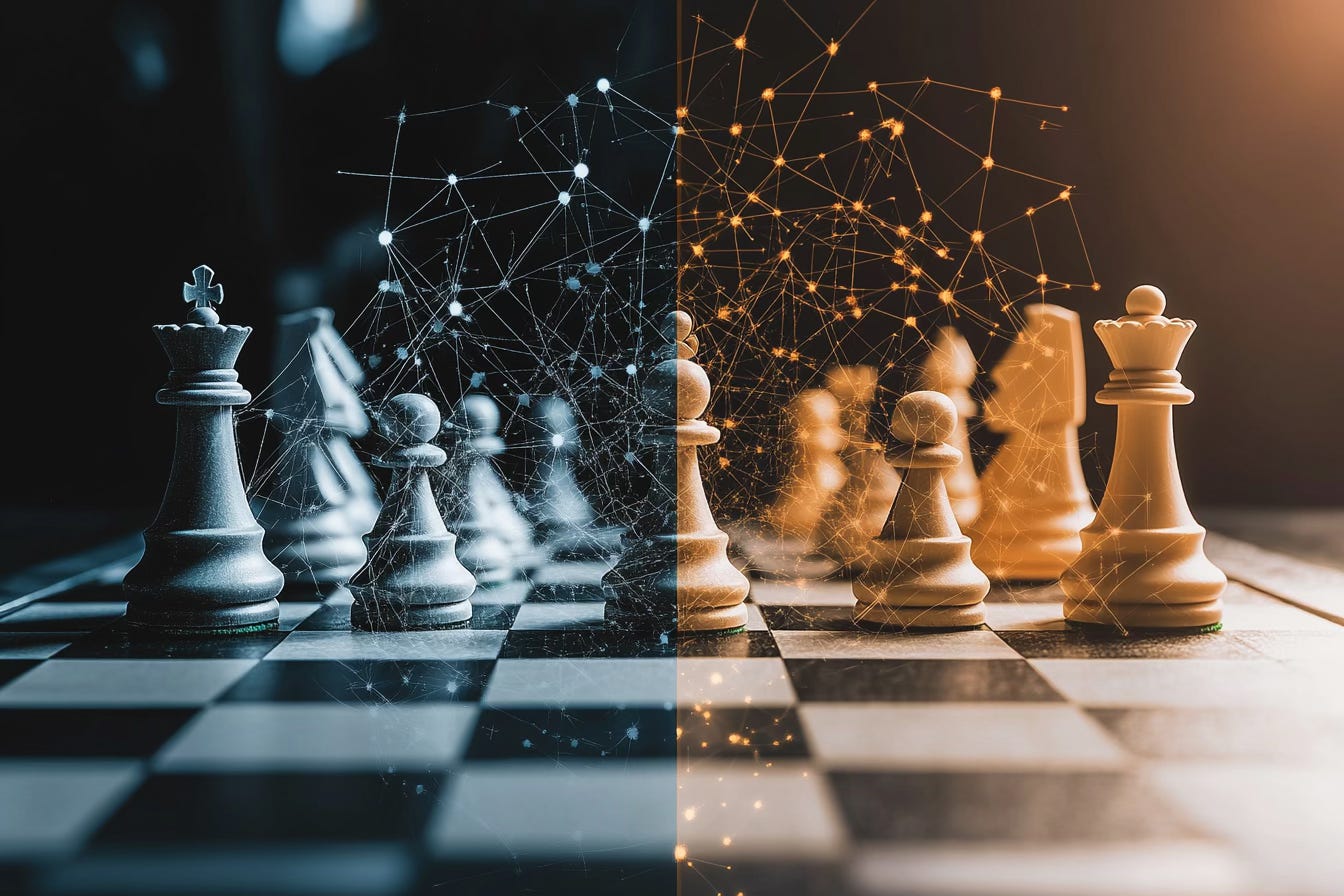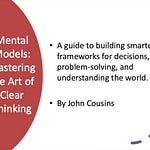"All meanings, we know, depend on the key of interpretation." — George Eliot
THE FUNDAMENTAL MENTAL MODEL
Pattern recognition is perhaps the most fundamental of all the mental models in our cognitive toolkit. It underpins our ability to make sense of a complex world, driving everything from our basic instincts to sophisticated analytical insights. Pattern recognition is the brain's remarkable capacity to identify regularities, trends, or meaningful relationships in data, experiences, or information—effectively turning chaos into order. When my first son was an infant, and I was a new dad, he would identify "samers" in his little books. I realized that he was training up his pattern recognition skills.
This mental model is uniquely powerful because it operates on multiple levels of consciousness. When you instantly recognize a friend's face in a crowd, you employ pattern recognition intuitively. When you notice that your company's sales consistently spike during certain seasons, you're using pattern recognition analytically. The versatility of this model makes it essential for navigating virtually every domain of life.
From an evolutionary perspective, pattern recognition offered our ancestors tremendous advantages. Those who could quickly identify the patterns of predator behavior, weather changes, or social dynamics had better chances of survival. Today, this capability allows us to excel in modern environments—from financial markets to interpersonal relationships.
What makes pattern recognition particularly valuable as a mental model is its dual nature: it's both innate and improvable. We're born with natural pattern-matching abilities, yet we can dramatically enhance these skills through deliberate practice and experience. This combination of natural aptitude and potential for growth makes pattern recognition a cornerstone for intelligent decision-making.
THE SCIENCE OF PATTERN RECOGNITION
Pattern recognition is deeply embedded in our neural architecture. When we encounter new information, our brains automatically search for familiar patterns—comparing current stimuli against stored templates and experiences. This process happens with remarkable speed, often before conscious thought can engage.
Neuroscience reveals that pattern recognition involves multiple brain regions working in concert. The visual cortex detects visual patterns, the temporal lobe processes patterns in language and sound, and the prefrontal cortex integrates these inputs with previous experiences. This distributed processing allows us to recognize patterns across different modalities simultaneously.
We generally recognize three primary types of patterns:
Spatial Patterns: Arrangements in physical space, such as facial features, constellations, or architectural designs.
Temporal Patterns: Sequences that unfold over time, such as speech, music, or market cycles.
Conceptual Patterns: Abstract relationships between ideas, like mathematical theorems, literary themes, or business strategies.
Experience plays a crucial role in developing pattern recognition skills. As we encounter similar situations repeatedly, our brains form stronger neural pathways, allowing for faster and more accurate pattern identification. This explains why experts in any field can often "see" patterns that novices miss entirely. Chess grandmasters, for instance, don't analyze every possible move; they recognize board patterns from thousands of previous games, allowing them to quickly identify promising strategies.
The interplay between intuitive and analytical pattern recognition creates a powerful cognitive system. Intuitive pattern recognition happens automatically and rapidly, while analytical pattern recognition involves conscious effort and verification. Both have their place:
Intuitive Pattern Recognition: Useful for quick decisions and familiar situations where speed is essential. "This investment opportunity feels similar to five others that performed well."
Analytical Pattern Recognition: Important for novel circumstances or when precision is critical. "Let me analyze these quarterly results to confirm if this growth trend is statistically significant."
This bifurcation is part of Daniel Kahneman's Thinking Fast and Slow conception. Understanding this dual system helps us leverage pattern recognition more effectively in decision-making.
PATTERN RECOGNITION IN DECISION-MAKING
Expert decision-making often relies heavily on pattern recognition. Contrary to the popular image of experts methodically weighing all options, research by psychologist Gary Klein revealed that experienced professionals typically use what he calls "Recognition-Primed Decision Making." When facing a situation, experts:
Recognize the situation as familiar (pattern recognition)
Understand what goals are reasonable and what cues are important
Form expectations about what might happen next
Identify a typical course of action based on similar past situations
This approach allows for remarkably rapid yet effective decisions. A firefighter captain doesn't analyze every possible strategy when entering a burning building; they recognize patterns that indicate structural instability or likely fire spread, then make decisions based on similar scenarios they've encountered.
The difference between novice and expert pattern recognition is stark:
Novices see surface features and isolated elements. A beginning chess player sees individual pieces.
Experts see underlying principles and meaningful relationships. A chess master sees dynamic force relationships and strategic possibilities.
This distinction explains why expertise cannot be reduced to simple rules. The expert's advantage lies in their rich library of patterns, built through years of experience and feedback.
Pattern recognition drives decision-making across domains:
In Business: Experienced investors recognize patterns in market behavior that signal opportunities or dangers.
In Medicine: Skilled diagnosticians recognize a constellation of symptoms that point to specific conditions.
In Sports: Elite athletes recognize subtle cues that allow them to anticipate opponents' actions.
In Leadership: Effective managers recognize patterns in team dynamics that indicate emerging problems or opportunities.
Developing strong pattern recognition skills allows us to make better decisions faster, even in complex and uncertain environments.
WHEN PATTERN RECOGNITION FAILS
For all its power, pattern recognition has significant vulnerabilities. Our eagerness to detect patterns can lead us astray, particularly when we:
See patterns where none exist: Known as apophenia, this tendency explains why people perceive faces in clouds, meaningful "hot streaks" in random gambling outcomes, or conspiracies in coincidental events.
Apply the wrong pattern: When we force new situations into familiar templates, we miss crucial differences. This explains many business failures, where executives apply strategies that worked in previous contexts to fundamentally different circumstances.
Fall prey to confirmation bias: Once we "see" a pattern, we tend to notice evidence that confirms it while overlooking contradictory information. This reinforces potentially false patterns.
Overgeneralize from limited data: Humans are remarkably quick to extract patterns from small samples, sometimes drawing firm conclusions from just a few observations.
Consider how these failures manifest in investing. An amateur investor might notice that three tech stocks they purchased all rose after product announcements. This limited sample might lead them to perceive a reliable pattern and invest heavily before future announcements, only to face substantial losses when the "pattern" proves coincidental rather than causal.
To verify if a perceived pattern is real, we can:
Seek disconfirming evidence: Actively look for cases where the pattern doesn't hold.
Test predictions: If a pattern is real, it should generate accurate predictions about future observations.
Consider alternative explanations: Ask what other factors might explain the apparent pattern.
Apply statistical rigor: When possible, use statistical methods to determine if a pattern exceeds what would be expected by chance.
Understanding these pitfalls helps us use pattern recognition more judiciously, knowing when to trust our pattern-matching instincts and when to question them.
IMPROVING YOUR PATTERN RECOGNITION SKILLS
While pattern recognition comes naturally to humans, the quality and sophistication of this ability vary tremendously between individuals. The good news is that, like any cognitive skill, pattern recognition can be systematically improved:
Immerse yourself in diverse experiences: Exposure to varied situations builds a richer pattern library. Cross-disciplinary knowledge is particularly valuable, as patterns from one domain can offer insights into another.
Practice deliberate comparison: Actively look for similarities and differences across situations. Ask: "How is this situation like others I've encountered? How is it different?"
Seek feedback on accuracy: Test your pattern-matching predictions and learn from both hits and misses. This feedback loop is essential for refinement.
Study exemplars: Examine classic cases or prototypical examples that clearly demonstrate important patterns in your field.
Categorize and name patterns: Articulating and labeling patterns makes them more accessible for future use. This explains why experienced professionals often develop specialized vocabularies.
Slow down occasionally: While pattern recognition can be rapid, deliberately slowing down to analyze ambiguous situations helps build more nuanced pattern recognition capabilities.
Use visualization techniques: Mentally rehearsing patterns and their variations strengthens neural connections associated with recognition.
Charlie Munger, Warren Buffett's business partner, exemplifies sophisticated pattern recognition in investing. He studies business histories across centuries and industries, building what he calls a "latticework of mental models." This diverse pattern library allows him to quickly recognize both opportunities and dangers in investment scenarios.
"I've long believed that a certain system—which almost any intelligent person can learn—works way better than the systems most people use," Munger noted. This system centers on recognizing patterns across disciplines and using them to inform investment decisions.
PATTERN RECOGNITION AND OTHER MENTAL MODELS
Pattern recognition doesn't operate in isolation; it enhances and complements many other mental models discussed throughout this book:
First Principles Thinking: Pattern recognition helps identify which situations warrant breaking down to first principles and which can be addressed through pattern-matching. The combination of both approaches is more powerful than either alone.
Bayesian Updating: Pattern recognition provides the initial hypothesis about a situation based on past experiences, while Bayesian thinking helps refine that hypothesis as new evidence emerges.
Inversion: By examining situations where expected patterns failed to materialize, we can better understand both the patterns themselves and their limitations.
Circle of Competence: Understanding where our pattern recognition is well-calibrated helps define the boundaries of our reliable knowledge.
Second-Order Thinking: Pattern recognition often reveals first-order effects, while second-order thinking helps us explore less obvious consequences that may follow.
For example, consider how an experienced investor might integrate these models:
They recognize a pattern in a company's financial statements that suggests undervaluation (pattern recognition)
They analyze the fundamental economic characteristics of the business (first principles)
They consider what might invalidate their pattern-based hypothesis (inversion)
They update their confidence as new quarterly results emerge (Bayesian thinking)
They anticipate how other investors might react when they eventually recognize the same pattern (second-order thinking)
This integration of multiple mental models, anchored by pattern recognition, creates a robust framework for decision-making in complex environments.
REAL-WORLD APPLICATIONS
The practical applications of pattern recognition span virtually every domain of human endeavor:
In Business and Investing: Pattern recognition underlies much of what we call business acumen. Ray Dalio, founder of Bridgewater Associates, built the world's largest hedge fund largely through pattern recognition abilities. His approach involves identifying "timeless and universal" economic patterns and creating decision rules based on them. This pattern-based approach helped his firm anticipate the 2008 financial crisis when most others missed the warning signs.
Similarly, Jeff Bezos recognized a pattern in technological adoption that others overlooked: the exponential growth of internet usage in the mid-1990s. This pattern recognition led him to found Amazon when many still doubted the commercial potential of the internet.
In Learning and Skill Acquisition: Effective learning strategies leverage pattern recognition. The most efficient learners look for underlying patterns rather than memorizing isolated facts. This explains why concepts are generally more transferable than procedures—they represent patterns that apply across situations.
Josh Waitzkin, chess prodigy and subject of the book "Searching for Bobby Fischer," attributes his ability to master multiple disciplines (chess, tai chi, Brazilian jiu-jitsu) to focusing on deep patterns rather than surface techniques. He learns fundamental patterns in one domain that can transfer to others.
In Problem-Solving and Innovation: Innovation often springs from recognizing patterns across different domains. The invention of Velcro came when George de Mestral noticed the pattern of burrs sticking to his dog's fur after walks. This natural pattern inspired a revolutionary fastening system.
James Dyson developed his revolutionary vacuum cleaner by recognizing a pattern problem in existing designs (loss of suction) and applying a pattern solution from an entirely different domain (industrial cyclone separators).
In Strategic Thinking: Military strategists, political leaders, and corporate executives all rely on pattern recognition to anticipate competitive responses. By recognizing patterns in an opponent's past behavior, they can predict likely future actions and plan accordingly.
THE CONTINUOUS DEVELOPMENT OF PATTERN RECOGNITION
Pattern recognition isn't merely a skill—it's a lens through which we perceive and interpret the world. As with any lens, its clarity and focus determine what we can see and understand. By actively developing our pattern recognition abilities, we enhance our entire cognitive system.
The most successful pattern recognizers share key characteristics:
They remain perpetually curious, continuously adding to their pattern library
They balance confidence in recognized patterns with humility about their limitations
They integrate pattern recognition with other mental models for more robust thinking
They understand that pattern recognition skills require ongoing maintenance and refinement
As you continue developing your mental toolkit, pay particular attention to your pattern recognition abilities. Notice which patterns you recognize easily and which you miss. Seek diverse experiences that expand your pattern library. Practice articulating the patterns you perceive so they become more accessible and shareable.
Remember that pattern recognition operates on a spectrum from unconscious intuition to deliberate analysis. Both ends of this spectrum have value, and wisdom lies in knowing which to trust in different situations.
By cultivating sophisticated pattern recognition, you'll make better decisions faster, learn more effectively, solve problems more creatively, and confidently navigate complexity. In a world of increasing information overload, the ability to discern meaningful patterns from noise becomes not just an advantage but a necessity.
"The world is so full of a number of things, I'm sure we should all be as happy as kings." — Robert Louis Stevenson
Properly understood, these "things" form patterns, and recognizing these patterns is the foundation of intelligent decision-making and clear thinking.













